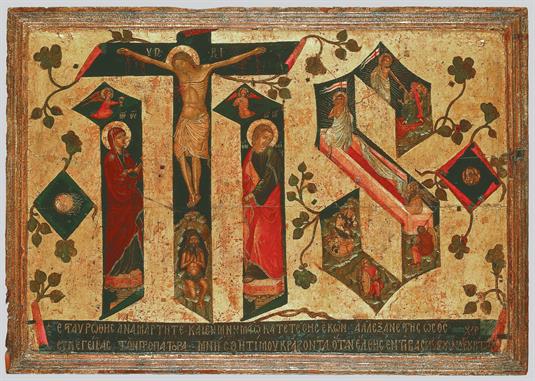Jesus Hominum Salvator
Depictions of the Crucifixion, the Resurrection and the Descent into Hell are combined in the initials of the abbreviated Latin inscription I(esus) H(ominum) S(alvator) (Jesus Saviour of Mankind), the emblem of the Franciscans. The Crucifixion is represented in the first two letters. In the letter S are depicted two successive scenes with the Risen Christ: The Anastasis, the Byzantine version of the Descent into Hell with the raising of the dead and the Western version of the Resurrection with Christ triumphant rising from the tomb. At the bottom on a black band with gold lettering, the Parakletike (Intercessionary) troparion, which is read at the early morning service on a Sunday, is inscribed.
Laboratory examination of the icon showed that the troparion and the name of the artist were added later, but they are identical to the initial incriptions.
The composition, unknown in either Byzantine or Western iconography, must be a creation of the Cretan artist Andreas Ritzos. This unique and original subject of the I H S is one of the most important examples of Italo-Cretan painting and shows the artist's familiarity with Western painting, as a result of the conditions prevailing in Venetian-ruled Crete in the 15th century.
The icon is, possibly, the one mentioned in 1611 in the will of the noble Andreas Kornaros, who was a member of an old Veneto-Cretan family and a prominent scholar. If the identification of the icon is correct, Andreas Kornaros had bequeathed the icon in an important individual in Venice, emphasizing its importance.
- Collection: Icons and Wood-Carvings
- Origin: Crete island
- Creator: Andreas Ritzos
- Measurement: 44,5 x 63,5 cm
- Exhibit Number: ΒΧΜ 01549
- Appears in: IV.1a. Society and art in Venetian Crete

Comments
Users must be registered and logged in to comment.
No comments found.